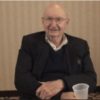University of California (Berkeley), CA
United States
Ruzena Bajscy
University of California (Berkeley), CA
United States
Research Areas
Autonomous Agents, Behavior-Based Systems, Biologically Inspired Robots, Brian-Machine Interface, Calibration and Identification, Cognitive Human-Robot Interaction, Compliance and Impedance Control, Computer Science, Computer Vision for Medical Robotics, Computer Vision for Transportation, Computing and Electronics, Contact Modeling, Cybernetics, Discrete Event Dynamic Automation Systems, Domestic Robots, Dynamics, Education Robotics, Education Robotics, Force and Tactile Sensing, Force Control, Haptics and Haptic Interfaces, Human Factors and Human-in-the-Loop, Human-Centered Robotics, Human-computer Interaction, Hydraulic/Pneumatic Actuators, Image Processing, Intelligent Transportation Systems, Kinematics, Machine Vision, Motion Control, Nonholomonic Motion Planning, Perception for Grasping and Manipulation, Physical Human-Robot Interaction, Physically Assistive Devices, Rehabilitation Robotics, RGB-D Perception, Robot Audition, Robot Companions, Robot Safety, Robots, Robust/Adaptive Control of Robotic Systems, Sensor Fusion, Service Robots, Soft Material Robots, Telerobotics and Teleoperation, Wearable Robots
Biography
Ruzena Bajcsy was born in 1933 and grew up in Czechoslovakia. Because of the family’s Jewish background, all of her adult relatives were killed by the Nazis in 1944. Declared to be war orphans by the Red Cross, she and her sister remained under the organization’s care until the end of the war. Despite moving between orphanages and foster parents, Bajcsy had no trouble at school and was a good student. Determined to have a career in electrical engineering, she earned a M.S. degree and a Ph.D. degree in the subject from Slovak Technical University. Shortly thereafter Bajscy was invited to study the new discipline of computer science at Stanford University, and so she came to the United States in 1967. She planned to stay in the country for one year. On hearing about the Russian invasion of Prague in 1968, however, Bajcsy decided not to return to Czechoslovakia. She remained at Stanford until 1972, earning a second Ph.D. degree in computer science there. For the next thirty years Bajcsy worked at the University of Pennsylvania, where she was Professor and Chair of Computer Science and Engineering, as well as Founder and Director of the University of Pennsylvania’s General Robotics and Active Sensory Perception (GRASP) Laboratory. After leaving Penn, Bajcsy headed the National Science Foundation’s Computer and Information Science and Engineering Directorate. Bajscy is currently Professor of Electrical Engineering and Computer Sciences and Director Emeritus of the Center for Information Technology Research in the Interest of Science (CITRIS) at the University of California, Berkeley. There she continues to do innovative research on machine perception, robotics and artificial intelligence, winning the 2009 Benjamin Franklin Medal in Computer and Cognitive Science for her recent work. Words of Wisdom “We as a robotics community during the last 30 years had many of the ideas in sensing, control modeling, building systems, showing feasibility in manufacturing, sensory fusion, grasping and mobility. What we were missing was the computer power, inexpensive memory, bandwidth in connectivity, better and cheaper sensors both vision and contact/force which now enables us to build systems that are proving the feasibility, robustness, cost effectiveness for real applications, hence the interest from Industry. I am emphasizing this so that my generation of researchers receives proper credit for the groundbreaking work we did, so that today’s generation can flourish. But I would also like to urge caution on the over exuberance of one technology (e.g. CNN) over all other approaches. We all know every technology has its limitations.” -Ruzena Bajcsy
Interview Synopsis
In this interview, Bajcsy talks about her experiences living, studying and working in Czechoslovakia and the United States. She discusses the impact of world events such as the Prague Spring on her educational and professional decisions. She also outlines the major projects on which she worked at the University of Pennsylvania, the National Science Foundation and the University of California, Berkeley. Aside from looking back at her own work with computers, Bajcsy reflects on the development of the wider field. Finally, she offers advice for young women who are considering a career in computing.







